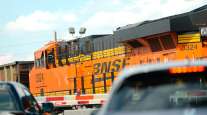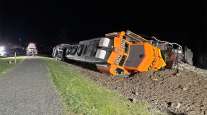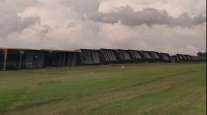BNSF Combining Technology, Human Expertise to Improve Operations

At Burlington Northern Santa Fe, it’s the combination of people and technology that’s making the railway safer and more efficient.
The railway is accomplishing this by using the “Internet of Things,” connecting computing devices to everyday objects and using the data collected to improve the way people live and work, according to Mike Garcia, General Director of the company’s Modern Business Intelligence and Mechanical Systems department.
Garcia described how BNSF is incorporating technology into its operations during a Feb. 27 lecture at Flathead Valley Community College in Kalispell, Mont. The lecture was the third of seven in the college’s “Technology and Humankind” 2018 Honors Symposium Lecture Series.
RELATED: BNSF joins group aiming to use blockchain in freight
Garcia has more than 15 years of experience in technology leadership roles across several industries, including energy, retail and transportation.
“The IoT starts with physical things — it might be people, it might be locomotives in our case, planes, engines — that have sensors on them that are measuring the physical aspects of whatever that is, generating data, and that data through some connection is getting somewhere,” Garcia said. “All of these sensors, all of this data, all of this analysis, it doesn’t mean anything or deliver any value if you don’t take action on the insights that are generated.”
Garcia used an example from his trip to Whitefish, Mont., to demonstrate how the Internet of Things works.
During his stay, Garcia hit the slopes at Whitefish Mountain Resort. His smartwatch tracked his movement with its internal accelerometer and gyroscope, and an app on his smartphone showed him the data collected during his time skiing.
However, he did note that the watch and app interpreted his downhill skiing as running, which he says shows the need for human interpretation in the Internet of Things.
“To me there’s a bigger story here, which is, ‘The data’s great, and the sensors are great, they’re capturing this movement and I can see it and do things with it,’ but again that person has to be in the loop. When I looked at this I said, ‘I wasn’t running, I was skiing,’” he said. “You can’t assume that what this system is trying to interpret from all these sensor is accurate, you have to have a person in that loop, giving feedback so that the system gets smarter.”
At the railroad, the Internet of Things covers tens of thousands of objects, providing a wealth of information.
RELATED: BNSF to spend $485 million in Texas, Oklahoma on maintenance projects
Garcia said BNSF is made up of 41,000 employees, 8,000 locomotives and 1,400 trains running per day, which move a quarter of the nation’s rail freight over 32,500 miles of track.
There’s a lot of assets, and a lot of things to measure, he said.
“If you think about it there’s lots of things in a railyard that we can attach sensors on to gather data and make better decisions about how we run those yards,” Garcia said.
For instance, simply tracking the temperature of things like wheels and bearings can tell BNSF a lot.
An increase in heat between sensors can mean something is making the system run inefficiently or a brake isn’t properly releasing, and the train can be stopped at the next station for inspection.
Being able to monitor these things without sending someone into a dangerous situation is always a plus, Garcia said.
“It is our priority to make sure that all our employees go home to their friends and families in the same condition that they came to work, period,” he said.
“This is just a great example of how we’re able to use sensors without putting a person at risk, without having somebody to get under the car and look at the brake pads and make sure everything is working. We’re able to leverage this technology to give us great insights about the overall health of these cars.”
Another development in technology at the railroad is a program of Unmanned Aerial Vehicles flown remotely over hundreds of miles of track.
The cameras on the UAVs can check to see if anything is sitting on the track or if a switch is set incorrectly. The cameras can even see the orientation of a bolt on the track and determine whether that bolt is tightened correctly.
“We’re using these unmanned aerial systems to fly 200 to 300 miles in a single mission and capture over 10,000 images each time they go out,” Garcia said.
As of Feb. 25, Montana became just the second state to get BNSF’s UAV coverage, joining New Mexico.
The system is based in Havre and the program itself comes out of a partnership with the Federal Aviation Administration.
The first Montana flight happened the Saturday prior to the lecture.
“We had some very brave souls from our telecom team climbing towers in very, very cold conditions,” Garcia recalled. “I don’t know how they did it, but I appreciate their tenacity in putting up the antennas and some of the infrastructure we need to be able to operate this program.”
So far, the Internet of Things at BNSF has been a positive addition to the way things are done.
For one, a dramatic decrease in derailments run directly with an increase in implementation of these technologies.
“The derailments that have been caused by mechanical failure on a locomotive or a railcar, we can see a measurable reduction in those. And if you look at those big jumps down, we can tie those to investments in the sensors that we place all across our network that are monitoring our rail traffic every day,” he said.
“This is something we’re proud of. We believe this is an area that we need to continue to invest in, one that generates great results and helps us to achieve those goals of safety, efficiency and reliability.”
And while new technologies always bring with them concerns over replacing traditional jobs done by people, Garcia noted how necessary people still are in the process.
The jobs are changing and new ones are coming along, he said. One example is the engineers who are now “pilots” at BNSF, running the UAVs from an office command center.
“We did not have this job three years ago, and there will be more like this. There will be new opportunities that IoT creates for the railroad,” Garcia said. “I know that some folks worry that with machine learning and artificial intelligence, we’re all going to be out of work. In our case, it’s creating new work for us.”
Distributed by Tribune Content Agency, LLC




